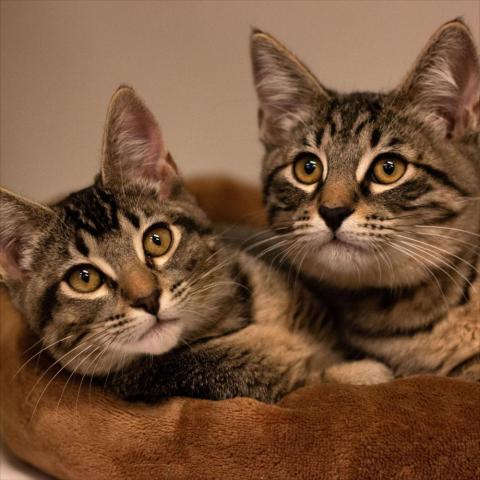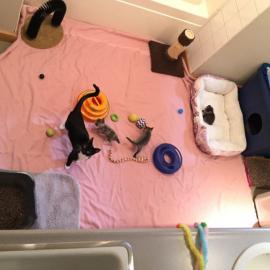猫咪领养手册
欢迎加入Multnomah县动物服务中心 (Multnomah County Animal Services, MCAS) 的猫咪领养计划。该收容所每年收容大约2100只成年猫。这些猫咪许多都患有疾病、曾受伤或受到惊吓,需要一些关爱。我们依靠我们的领养家庭来帮助我们治愈这些动物并帮助它们恢复状态,让它们过上新的健康生活。对于我们的部分猫咪,我们需要领养家庭为它们安置终身的住所,让它们感受到爱和温暖。领养有时是很有挑战性的,但回报是巨大的,没有领养家庭的帮助,我们无法做到这一点。
MCAS团队感谢您选择成为领养主人!
目录
- 通知
- 接回动物
- 后续问诊
- 领养
- 喂养
- 清理
- 创造安全港湾
- 不使用猫砂盆
- 过度警觉
自信猫咪计划 (Confident Cat Program)
- 安置场所
- 触摸
- 为领养做好准备
- 如果猫咪和我不亲近,我该怎么处理
- 腹泻
- 呕吐
- 跳蚤
- 耳疥癣
- 上呼吸道感染 (URI)
- 癣
- 猫免疫缺陷病毒/猫白血病病毒 (FIV/FeLV)
- 慢性肾功能衰竭
- 甲状腺功能亢进症
- 早上8点到下午5点半之间的紧急情况:
- 下午5点半到早上8点之间的紧急情况:
- 一般事件 - 适当的监控
- 非紧急事件 - 请发送电子邮件至foster-medical-help@multco.us联系动物健康部,以询问是否需要问诊。
- 紧急情况 - 需要即刻关注 - 请参阅上一页的“紧急情况”以获取指导
- 问:我可以让我领养的猫咪和我的宠物互动吗?
- 问:我需要投入多少时间来养猫咪?
- 问:在MCAS领养的宠物如何进行治疗?
- 问:每只宠物的领养时间是什么时候?
- 问:猫咪需要领养的常见原因有哪些?
- 问:如果我领养的猫咪咬人了,该怎么办?
- 问:如果我领养的猫咪逃跑了,该怎么办?
- 问:如果我还想领养一只猫咪怎么办?
- 问:如果我的一位朋友或家人想领养怎么办?
- 问:我该如何开始?
领养流程
通知
如果有急需领养的猫咪,我们会通过电子邮件发送请求,但通常每周发送一到两次。有领养意愿的人士可以回复电子邮件或致电领养协调员。
领养协调员还会维护开放领养家庭的名单,以便在匹配时直接联系。如有任何领养意愿,请通知领养协调员。
接回动物
您需要和领养协调员预约接回猫咪的时间。带上您的猫背包,到达时到前台办理登记手续。
您需要签署领养协议,并且我们会为您提供包括病历、行为记录以及曾用药物在内的相关文件。
后续问诊
每只猫咪需要进行后续问诊的情况会有所不同。有些可能需要经常问诊,有些则仅需每月问诊一次。如需进行后续医疗问诊,请联系动物健康部:foster-medical-help@multco.us。如需其他预约,请联系领养协调员:foster@multco.us。
领养
由于医疗原因而被领养的猫咪在被领养之前需要得到动物健康部的批准。一般来说,这些猫咪在接受复查得到批准后会被送回MCAS继续寻求领养。由于行为原因而被领养的猫咪,将由猫咪专家或领养协调员决定是否可以被领养。届时将决定它们是应该送回MCAS还是留在领养家庭接受领养。在宠物获准领养之后,我们建议领养主人尽快与他们的宠物见面。所有有领养意愿的人士都需要前往MCAS进行领养咨询。
在动物获准可以从收容所或您家里被领养之前,请向领养协调员提供一张清晰的照片和网站上的简介。简介应该包括关于它们理想的家庭环境,以及它们的优秀品质或怪癖的信息。介绍它们与其他宠物相处的情况(如果您了解的话),最好也介绍它们的运动需求以及它们与您独特的互动情况。请以第一人称撰写简介,以更好地吸引潜在领养者的注意。
基本原则
喂养
除非动物健康部另有指示,否则您需要确保您领养的猫咪随时有优质的猫咪干粮食用。您也可以为您领养的猫咪提供猫粮罐头。老年猫、病猫或超重的猫咪可能会从额外的罐头食品中受益。猫咪还应该可以随时喝到新鲜的水。
为猫咪提供零食是建立关系和鼓励积极行为的好方法,适度给予也是可以的。您不应该为您领养的猫咪喂食牛奶或任何本手册未列出的人类食品。如果您的猫咪在进食时感到不适,请参阅“常见医疗问题”部分的提示框以获取关于获批的人类食品的信息。
清理
在领养新的猫咪回家之前,清理您的安置场所十分重要。您需要将漂白剂和冷水按照1:32的比例进行混合,然后清洗所有坚硬的表面,包括墙壁和地板。盛放食物的碗、玩具和猫砂盆应该在溶液中至少浸泡10分钟。任何柔软的材料,如毛巾、地毯和毛毯,都应该使用漂白剂进行高温洗涤。任何不能清洗的纸板或其他物品都应丢弃。领养的猫咪只能接触可以用漂白剂消毒或可以丢弃的表面。无法消毒的区域可能会留有可能传播给其他动物甚至人类的细菌。地毯无法适当消毒,我们强烈反对让领养的猫咪接触地毯。
创造安全港湾
领养的猫咪应该只呆在室内,如果需要外出,则需要装进安全的笼子里。到达您的家后,即使是自信的猫咪也可能需要一些时间来适应,因此在最初的两周内需要限制它们的活动空间。一间小房间、浴室或大型狗笼都可以作为它们的安置场所。为猫咪创造安全的藏身之处,而您又能找到它们。垂直空间也很重要 - 在窗户或其他会吸引猫咪视线的地方放置桌子或书架,为猫咪提供简单而有效的栖身之所,当它们可以跳离地板时,它们会感到更加自信。确保将食物、水和猫砂盆放置在人少的地方。在开始的几天里,限制猫咪与陌生人的交流。
常见行为问题
请谨记,您领养的猫咪最近历经了几次艰难的变迁,这一点至关重要。它们对一些事情感到不确定,尽管我们知道领养家庭是一个很棒的地方,但它们可能在过渡期时仍然会感到不适应。耐心是关键,以下建议有助于帮助您解决一些常见的问题。
不使用猫砂盆
成年猫不使用猫砂盆有医学和行为两方面的原因。大多数问题都很容易解决。首先要确定猫咪是否漏尿,或者排便是否正常。如果您在垂直的表面上有发现尿液,那么您的猫咪正在漏尿,如果在水平面上有发现尿液,那么您的猫咪就可能有排尿不当的情况。如有任何情况,请立即通知领养协调员。
漏尿很可能是压力导致的缘故。来到一个全新的家庭(即使是一个非常好的领养家庭)、有另一只宠物的存在,或者近来一直都还处于适应新环境的状态,这些原因都可能导致这种行为。猫咪正在努力适应,让自己感觉更安全。首先评测导致猫咪漏尿的可能原因。将猫咪关在一个较小且易于清洁的空间内,与孩子和其他宠物分隔开。
排尿不当或排便不正常可能是压力导致的结果,但也有可能是因为猫咪不喜欢猫砂盆类型、猫砂盆位置、缺少适当数量的猫砂盆,或是猫咪有关节炎或尿道感染等原因而引起。要解决这个问题,首先要保持猫砂盆的干净。每天铲几下猫砂盆,每周彻底清洁并消毒。为您领养的猫咪提供多个猫砂盆,如果可能的话,在它们使用的地方再放一个以供备用。用无盖的猫砂盆装上无味的猫砂,如果需要的话,试试其他种类的猫砂,看看它们喜欢哪一种。例如,您可以尝试结块、非结块、颗粒、小麦,甚至土壤猫砂。还有Cat Attract猫砂,这种猫砂含有酶,可以诱导猫咪进入猫砂盆。
在这两种情况下,请确保使用专门设计用来解决猫尿问题的酶清洁剂彻底清洁猫咪的患处。清洁后,您可以使用Feliway作为辅助治疗。如出现排尿困难、尿中有血或频繁尝试排尿而不能正常排尿的情况,应立即向动物健康部报告。
过度警觉
过度警觉可能表现为猫咪对刺激它们的东西进行攻击、咆哮甚至咬人。对象可能是另一只猫咪、一只狗狗,也可能只是简单的抚摸。部分猫咪比其他猫咪更容易出现这种行为。针对这些行为,我们应该设法减少对引起这种反应的事物的接触。您可以带走其他宠物,或者您在抚摸猫咪时换一个更让它们感到舒适的位置,或是限制时间。在您了解了猫咪的敏感点之后,您就可以开始研究如何让它们不再敏感。您可以用零食或湿的食物让猫咪慢慢适应这些刺激。慢慢来!例如,放置另一只猫咪的照片,然后喂养零食。逐渐增加猫咪对刺激物的接触,谨慎地在触及它们的敏感点之前停下来。每次练习的时间要短,并且每天练习几次。
有些猫咪会在玩耍时而引起过度刺激。您不应该鼓励您领养的猫咪咬或踢您的手或脚。可以用魔杖或悬空玩具鼓励猫咪适当地玩耍,并将它们从您的身体上移开,以免伤及到您。游戏时间要短,在它们过于兴奋之前结束。始终奖励积极的互动和行为,而忽视消极的行为。
自信猫咪计划 (Confident Cat Program)
收容所是一个为猫咪而忙碌的场所。很多猫咪在这种环境中会感到不适应,可能会表现出极度的恐惧甚至过激行为。这些猫咪中有一些是受惊吓的家猫,当提供它们一个比较安全的环境时,它们就会很友好。另一些则是社交能力不足的猫咪,它们可能永远不会在与人互动时感到舒服。一般来说,为它们安置一个领养家庭是确定差异的最好方式。通过实施以下计划,我们应该能在短短几周内知道其中的差异。该计划一再被证明十分有效。如果您发现您在三周内无法完成这些举措,请与领养协调员联系,告知最新情况,我们将制定新的计划。
安置场所
计划中最重要的一个环节就是为猫咪选择一个正确的安置场所。一般来说,最开始选择大狗笼、滚笼或小型浴室是最好的安排。理想的情况是,猫咪应该能够观察到正常的家庭活动,但又不能完全被这些活动所干扰。应该给猫咪提供一个隐藏的空间,这样它们就可以休息一下,但要确保您能够找到它们。根据需要调整适应区域的位置,以保持平衡。不应该允许处于恐惧状态的猫咪能够进入整个房子的各个区域。这将大大增加它们与人类亲近所需的时间,可能会使我们对它们的社会化程度做出不准确的评估。
触摸
首先,为您领养的猫咪提供它们喜欢的食物 - 罐头食品、婴儿食品、罐头食品中的金枪鱼油等,然后走开。争取每天进行三到五次。建立一个它们可以预测的日常惯例。在喂养它们几天后,开始在该区域停留。在接下来的一周里,在猫咪进食的时候,逐渐靠近它们的住处。如果它们停止进食,您就是离得太近了。继续呆在它们可以接受的范围内,但要保持更长的停留时间,直到您能够坐在它们的住所旁边。接下来,试着把您的手放在食物附近。然后试着把手伸向宠物的脸上或头上。如果这一步骤进行得太过频繁,您可以尝试用无生命的物体抚摸,比如魔杖玩具或挠背器。当它们停止进食时,您需要停止进一步的举动。
继续这些互动,直到您能够舒适地借助喂食来抚摸它们。其次,您要尝试在提供食物之前先抚摸,抚摸后再给予食物。试着用食物或玩具把猫咪哄到您的腿上。在这段时间期内,继续保持家庭内发出的正常的声音。
在猫咪对您的抚摸感到舒服,并做出积极的回应时,您就可以扩大它们的生活空间。继续供应食物或玩具作为与您互动的奖励,以此提高信任度。
为领养做好准备
在您能够自信地抚摸您领养的猫咪之后,请将您的描述和简介通过电子邮件发给领养协调员。在被列入领养名单之前,您不需要把它抓起来放在房间里,把它抱起来,或者让它依偎在您身旁。领养家庭将被告知如何在他们家里继续您的计划。我们想为领养家庭提供一个良好的基础,但同时也想让他们有能力去帮助猫咪,这样我们就可以帮助下一只需要帮助的猫咪。
如果猫咪和我不亲近,我该怎么处理
每只猫咪的进步速度都不一样,但一般来说,到第三周时,您应该可以抚摸您领养的猫咪,即使它们不一定喜欢抚摸。如果情况仍然没有好转,您应该联系领养协调员寻求建议。可以决定让这只猫咪加入Kitties for Hire计划。并不是所有的猫咪都能与人类交往,不过也没关系,也有专门为这些家伙安置的家。遵循此计划,可以帮助我们快速确定最佳的计划,而不会给猫咪造成不必要的压力。
常见的健康问题
所有的猫咪在被领养前都会接受健康检查,任何已知的健康问题都会在接猫之前与领养主人讨论。不过,也有可能在猫咪被领养回家后才出现症状。正因为如此,将您领养的猫咪安置在单独的区域、备有单独的寝具,并且不与家里的其他宠物接触,这一点非常重要。如果领养宠物与其他动物共享了某些食物,MCAS不负责治疗领养家庭中的任何其他动物。
预计所有兽医护理将由MCAS提供,或经批准的急诊兽医仅在紧急情况下提供。领养主人不得将领养宠物交给任何其他兽医。未经MCAS兽医工作人员的预先批准,不得给领养宠物服用药物、处方药或其他药物。如果不遵守这一规定,可能会导致丧失成为MCAS动物领养主人的资格。任何未经授权的兽医护理服务,MCAS将不予报销。
腹泻
引起腹泻的原因有很多,包括饮食的改变和压力。来到您家庭的头几天会出现便便过稀或腹泻的情况。如果大便没有改善,可能说明有更严重的问题。如果持续超过72小时,或伴有嗜睡、食欲不振或呕吐的症状,应联系动物健康部。
呕吐
呕吐也可能是因压力或饮食改变的缘由,应注意观察。如果呕吐持续超过48小时或伴有嗜睡或食欲不振的症状,应联系动物健康部。
跳蚤
在可能的情况下,您领养的猫咪在与您回家之前,会进行跳蚤治疗。应该每月都进行跳蚤治疗。请与动物健康部联系进行后续治疗。
耳疥癣
患有耳疥癣的猫咪,耳朵里会有结痂的黑色碎屑。耳朵经常会发痒,并可能有难闻的气味。药物治疗很简单,但有时需要多次治疗才能完全治愈。
上呼吸道感染 (URI)
上呼吸道感染 (Upper Respiratory Infection, URI) 只是一种猫咪感冒的症状。一般由病毒引起,但也可能涉及细菌感染。压力会让猫咪更容易感染。
URI症状的一般表现为打喷嚏、眼或鼻分泌分泌物、充血和咳嗽或眼睛肿胀。
URI症状轻微的病例不需要看兽医。如果猫咪有明显的鼻腔分泌物,并且进食正常、体重增加以及其他行为正常,则可能不需要问诊。大多数URI症状轻微的猫咪会在七到十天内自行恢复。如果猫咪URI病情仍然没有好转,或者猫咪出现嗜睡、食欲不振、体重减轻、流鼻涕、严重充血或发烧的症状,应联系动物健康部。
癣
我们地区的成年猫身上出现癣十分罕见。这是一种真菌感染,通常见于头部和腿部。感染部位的皮肤看起来很干燥,毛发也会脱落。癣是可以治疗的,通常需要药浴和口服药予以治疗。它对其他动物和人类有很强的传染性,可以在家里存活很长时间。如果您怀疑您所领养的猫有感染癣菌病,请联系动物健康部。
猫免疫缺陷病毒/猫白血病病毒 (FIV/FeLV)
MCAS根据当地许多收容所的规定,不会对猫咪进行猫免疫缺陷病毒/猫白血病病毒 (Feline Immunodeficiency Virus/Feline Leukemia Virus, FIV/FeLV) 的常规检测。检测将由动物健康部自行决定。当得知猫咪对其中一种病毒的检测呈阳性时,相关人员会与领养家庭沟通。FIV一般只通过深层的打斗伤口和交配传播。FeLV更容易传播,其中包括通过密切接触(如相互梳理毛发)和唾液传播。该病毒在环境中的存活时间并不长,正常的清洁程序可以消除环境对其他猫咪的危害。
慢性肾功能衰竭
慢性肾功能衰竭也就是肾脏疾病,是老年猫的常见病,病因有多种。每只猫的病情发展速度不同,很难预测疾病发展的时间。您领养的猫咪可能会比正常情况下喝更多水以及排尿量增大。还会出现体重减轻、食欲不振、精力下降、贫血、呕吐等症状。我们会建议您使用处方喂食,并且该处方由MCAS提供。必须确保这些猫咪随时都能喝到水。
甲状腺功能亢进症
甲状腺功能亢进症在老年猫中也很常见。它是由甲状腺功能异常而引起的。它会导致猫咪过量饮水和排尿、躁动、呕吐或腹泻。猫咪虽然食欲旺盛,但体重常常下降。一般需要终生服药,以及需要确保这些猫始终有水喝。
临终关怀
MCAS有一个临终关怀计划,专门针对那些进入收容所的病入膏肓的猫咪。这些动物可能有各种各样的医疗状况,但仍然有良好的生活质量。MCAS将为这些猫咪提供安宁疗护,并要求我们的领养家庭为它们安置一个充满爱心和温暖的家。
临终关怀计划的猫咪需要每月在MCAS进行复查,偶尔可能会出现可以结束待在此计划的情况,并获批准可以被领养。在您每次的问诊中,动物健康部都会协助您为这些猫咪制定最佳计划。
临终关怀的猫咪需要进行皮下输液和/或药物治疗十分常见。动物健康部可以向任何人展示这个过程。我们也可以根据需要带猫咪前往MCAS进行输液。
监测您临终关怀计划的猫咪的生活质量十分重要。猫咪特别善于隐藏疼痛和不适。作为它们的照顾者,我们需要寻找它们可能准备好离开的更微妙的迹象。这些迹象可能包括:食欲不振、体重明显下降、使用猫砂盆的习惯改变、心情差的日子比心情好的日子多、呼吸困难或行为改变。如果您担心上述任何症状,请联系动物健康部。动物健康部擅长做出这些决定,并在此与您共同探讨这一过程。
所有的领养,但尤其是临终关怀,是一个特殊的过程,需要极大的同情心。请参阅本手册末尾的“其他资源”页面,以了解关于悲痛援助方面的一些帮助。要知道,工作人员也会帮助您度过这段旅程中的困难时期。
紧急情况
早上8点到下午5点半之间的紧急情况:
- 请发送电子邮件至foster-medical-help@multco.us和致电503-988-9075联系医疗团队。请留言。
- 立即前往收容所!不要等待回应。
- 请随身携带动物ID号码,并在任何可能的时候提供该号码,但不要让它耽误您的时间。
下午5点半到早上8点之间的紧急情况:
- 如果您不确定是否为紧急情况,请参阅您的领养联系表,获取当前领养导师的名单以寻求指导。
- 将宠物带到以下经批准的兽医诊所(非营业时间同样开放)。
Dove Lewis
1945 NW Pettygrove St
Portland, OR 97209
503-228-7281
NW Veterinary Specialists
16756 SE 82nd Dr
Clackamas, OR 97015
503-656-3999
- 如果可能的话,带上您领养家庭的医疗记录。
- 告知诊所,这是在MCAS领养的宠物,他们将不会向您收取服务费用。
- 请尽快通知MCAS,您已通过发送电子邮件至foster-medical-help@multco.us和致电503-988-9075将您的宠物带往兽医诊所(非营业时间同样开放)。请附上动物编号。
一般事件 - 适当的监控
- URI
- 有明显的眼或鼻分泌物,打喷嚏
- 除此之外猫咪还在正常吃东西和活动
- 少于48小时的食欲不振(猫咪仍在活动)
- 少于48小时的嗜睡(精力不足)
- 少于24小时的呕吐(猫咪仍在活动并进食)
- 少于3天的腹泻(猫咪仍在活动并进食)
- 少于48小时没有排便
- 体重减轻不到10%
非紧急事件
请发送电子邮件至foster-medical-help@multco.us联系动物健康部,以询问是否需要问诊。
- URI
- 有明显的眼或鼻分泌物
- 猫咪出现任何程度的嗜睡或厌食的迹象
- 腹泻
- 3天后排便情况无改善(如果猫咪仍然活动和进食)
- 持续24小时的腹泻(如果猫咪嗜睡和厌食)
- 呕吐
- 24小时后无改善(如果猫咪仍然活动和进食)
- 少于24小时的呕吐(如果猫咪嗜睡和厌食)
- 超过48小时的食欲不振
- 超过48小时的嗜睡
- 超过48小时没有排便
- 体重减轻超过10%
- 脱毛
- 皮肤或耳朵感染
- 眼睛肿胀或闭合(可能是紧急情况,请联系寻求指导)
- 轻度外伤、疼痛或跛足
- 轻度出血,不再活跃
- 抽搐发作(谨一次,持续时间短)
紧急情况 -需要即刻关注 - 请参阅上一页的“紧急情况”以获取指导
- 反应迟钝或瘫倒在地
- 严重的外伤或疼痛
- 呼吸吃力或呼吸困难
- 试图排尿24小时后仍然没有排出
- 大量活动性出血
- 抽搐(24小时内超过3次或1次持续3分钟以上)
- 持续呕吐超过24小时,无法吞咽食物/水
常见问答
问:我可以让我领养的猫咪和我的宠物互动吗?
答: 我们会尽力向领养主人告知猫咪可能患有的所有已知疾病。不幸的是,可能会出现它们携带疾病或寄生虫,但是相当长的一段时间没有出现症状的情况。我们强烈建议始终将领养的猫咪和个人宠物分隔开。我们建议至少有两周的检疫期。个人宠物必须接种最新的疫苗,预防寄生虫,并且保持健康。
问:我需要投入多少时间来养猫咪?
答: 每种情况下,时间的投入会有所不同,但一般来说,您可以每天花一到三个小时的时间与您领养的猫咪进行某种形式的互动。对于因行为原因而被领养的猫咪来说,这段时间最好分成十分钟的小段时间。
问:在MCAS领养的宠物如何进行治疗?
答: 作为MCAS的领养主人,您需要与我们的现场兽医工作人员合作,处理早上8点到下午5点30分发生的所有日常护理和紧急情况。 这意味着在您领养猫咪的整个过程中,您可能需要多次前往我们的工作地点。
问:每只宠物的领养时间是什么时候?
答:每只猫咪需要领养的时间也会有所不同。一般来说,感冒的猫只需要两周左右的时间,而临终关怀的猫可能需要长达六个月的时间。不过也有不同的情况,每一种情况都是独一无二的。领养申请一般会给您提供一个预期的时间范围。
问:猫咪需要领养的常见原因有哪些?
答: 当猫咪正在从疾病或受伤中恢复、有行为问题、收容所让它们不堪重负或需要临终关怀时,它们通常需要一个领养家庭。
问:如果我领养的猫咪咬人了,该怎么办?
答:如果您的猫咪咬人,导致流血受伤,您必须在事件发生后的24小时内联系领养协调员。法律要求对所有的咬伤事件进行记录,并对动物进行检疫。这包括本质上不具攻击性的咬伤。检疫过程很简单,要求猫咪在您的家中或收容所中呆10天,并且要与以前未与之互动的人和宠物隔离。我们希望尽可能避免这些情况,但如果事情确实发生了,我们会在此帮助您和猫咪度过这一过程。
问:如果我领养的猫咪逃跑了,该怎么办?
答:如果您领养的猫咪逃跑了,您应该尽一切努力让它们尽快回到家中。如果您无法迅速找到它们,请在MCAS宠物走失和寻回网页上提交宠物走失和寻回报告,并联系领养协调员。
问:如果我还想领养一只猫咪怎么办?
答:领养照顾者可以领养他们的领养猫。他们需要告知领养协调员,前往MCAS完成领养申请程序,并支付标准的领养费
问:如果我的一位朋友或家人想领养怎么办?
答: 我们鼓励领养主人通过朋友、家人或社交媒体为他们的猫咪寻找领养者。拟定的领养者应在猫咪被批准领养后,在正常的工作时间内前往收容所与领养顾问见面。
问:我该如何开始?
答: 参加信息发布会!这是所有MCAS志愿者开展工作的第一步。通常是在每月的第四个星期三的晚上7点到8点,但是您可以访问我们的网站multcpet.org/events以确认日期和时间。
其它资源
- www.aspcapro.org-关于动物收容所及其护理服务的各种主题的资源。
- www.maddiesfund.org-另一个非常有用的资源,可提供各种信息,包括许多操作视频。
- www.sfspca.org -旧金山防止虐待动物协会 (Society for the Prevention of Cruelty to Animal, SPCA) 有关于猫咪行为的在线图书馆。还有关于临终关怀领养和小猫领养的资料集。
- www.dovelewis.org/pet-owners/pet-loss-support Dove Lewis拥有大量关于宠物走失支持的资源,包括艺术治疗、纪念仪式和悲痛援助。
- https://bestfriends.org/resources/cats -Best Friends是美国最大的不杀生动物保护区 (No-Kill Animal Sanctuary)。他们的网站上有很多很棒的有关行为问题和医疗状况的技巧。
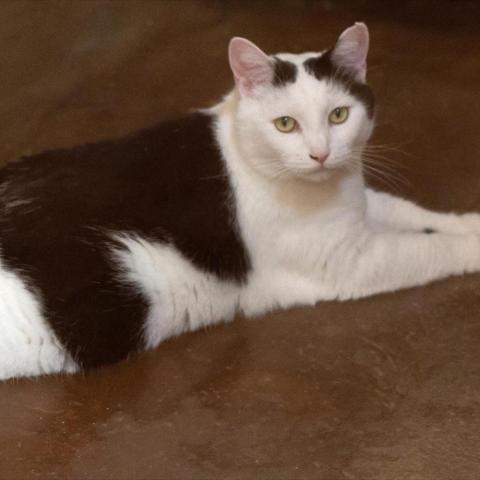
Table of Contents
- Notification
- Pickup
- Follow-up Appointments
- Adoption
- Feeding
- Cleaning Up
- Creating a Safe Haven
- Not Using the Litter Box
- Overarousal
- Set Up
- Handling
- Getting Ready for Adoption
- What If They Don’t Come Around
- Diarrhea
- Vomiting
- Fleas
- Ear Mites
- Upper Respiratory Infection (URI)
- Ringworm
- FIV/FeLV
- Chronic Renal Failure
- Hyperthyroidism
- For emergencies between the hours of 8AM and 5:30PM:
- For emergencies between the hours of 5:30PM and 8AM:
- Not Immediately Concerning - Appropriate to monitor
- Non-Emergency - Contact Animal Health at foster-medical-help@multco.us to see if an appointment is needed.
- Emergency - Requires immediate attention - See “Emergencies” on previous page for guidance
- Q: Can I let my foster Cat interact with my personal pets?
- Q: How much time will I need to dedicate to fostering cats?
- Q: How does medical treatment work with an MCAS foster pet?
- Q: How long will I be fostering each pet?
- Q: What are the common reasons that cats need fostering?
- Q: What should I do if my foster cat bites someone?
- Q: What should I do if my foster cat escapes?
- Q: What if I want to adopt one of my foster cats?
- Q: What if one of my friends or family members wants to adopt?
- Q: How do I get started?
Fostering Process
Notification
A request for the cats that are in need of foster will be sent out in an email as the need arises but generally once or twice a week. Interested parties can respond to the email or call the Foster Coordinator.
The Foster Coordinator will also maintain a list of open foster homes to contact directly when a match comes up. Please notify the Foster Coordinator of any particular interest.
Pickup
You will make an appointment with the Foster Coordinator to pick up the cat. Bring your carrier with you and check in at the front counter when you arrive.
You will be asked to sign a foster agreement and be provided with paperwork including pertinent medical and behavioral records, medications.
Follow-up Appointments
The need for follow up appointments will vary with each individual cat. Some may need to be seen quite often and others as infrequently as once a month. For follow up medical appointments, please contact Animal Health at foster-medical-help@multco.us. For all other appointments, contact the Foster Coordinator at foster@multco.us.
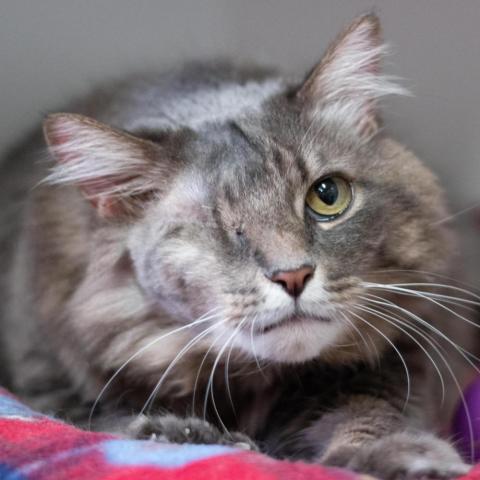
Adoption
Cats that are in foster care for a medical reason will need to be cleared by Animal Health prior to being made available for adoption. Generally speaking, these cats will be returned to MCAS for adoption after being cleared at their recheck appointment. Cats that are in foster care for a behavior reason, will be made available for adoption at the discretion of the Feline Specialist or the Foster Coordinator. The determination at that time will be made whether they should return to MCAS or stay in the foster home for adoption. Once cleared for adoption, foster parents are encouraged to network their animals. All interested parties will need to come to MCAS for an adoption counseling.
Prior to an animal being made available for adoption either at the shelter or from your home, provide the Foster Coordinator with a clear photo and a biography for the website. The biography should include information about their ideal home setting and some of their great qualities or quirks. Include information about how they are with other pets, if known, their exercise needs and their unique interactions with you. Write the biography in the first person to better grab the attention of the potential adopter.
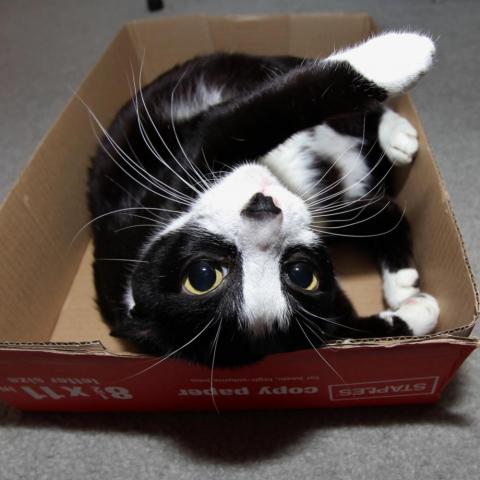
Adoption Promotion Tips
- Create a short (~30 seconds) Youtube video and email the link to the Foster Coordinator to load on the website
- Email the Foster Coordinator new photos-a different photo every week or two is ideal.
- Email the foster Coordinator a modified bio-focus on other traits or try a new wording.
- Print posters and put them up at local businesses
- Social media-utilize, Facebook, Instagram, Twitter etc.
Fostering Basics
Feeding
Your foster cat should have access to a good quality dry cat food at all times, unless otherwise instructed by Animal Health. You can also offer your foster cat canned cat food. Senior, ill, or overweight cats may benefit from additional servings of canned food. Cats should always have access to fresh water.
Treats formulated for cats are a good way to build relationships and encourage positive behaviors and are also ok to give in moderation. Your foster cat should not be given milk or any human food that is not listed in this manual. If you have a cat that is struggling to eat, see the tip box in the Common Medical Concerns section for approved human food suggestions.
Cleaning Up
Prior to bringing home a new foster cat, it is important to clean your foster space. You will want to use a 1 part bleach to 32 parts cold water mixture to wash any hard surfaces including walls and floors. Food bowls, hard toys and litter boxes should be soaked in the solution for a minimum of 10 minutes. Any soft materials, such as towels, rugs and blankets, should be washed on a high temperature with bleach. Any cardboard or other items that cannot be washed should be discarded. Foster cats should only be given access to surfaces that can be disinfected with bleach or discarded. Areas that cannot be disinfected could hold onto germs that could be spread to other animals or even people. Carpet cannot be properly disinfected and we strongly discourage allowing foster cats to have access to it.
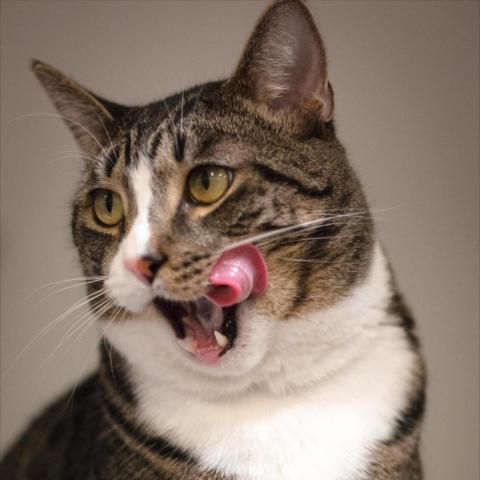
Creating a Safe Haven
Foster cats should be kept indoors only and be transported in a secure crate when outside of the home. Upon arrival to your home, even a confident cat may take some time to adjust and should have their space limited for the first two weeks. A small room, bathroom or a large dog crate work well. Create hiding places where the cat can feel safe but you are able to reach them. Vertical space is important as well - placing a table, or a bookshelf, by a window or other place of visual interest, provides an easy and effective perch for cats who feel more confident when they are elevated off the floor. Make sure that food, water and litter are in places that are low traffic. Limit interactions with new people for the first several days.
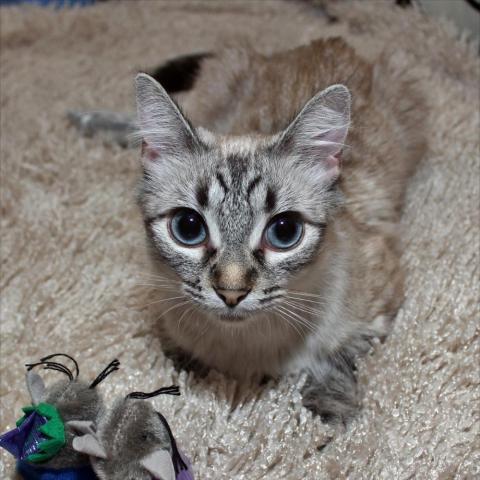
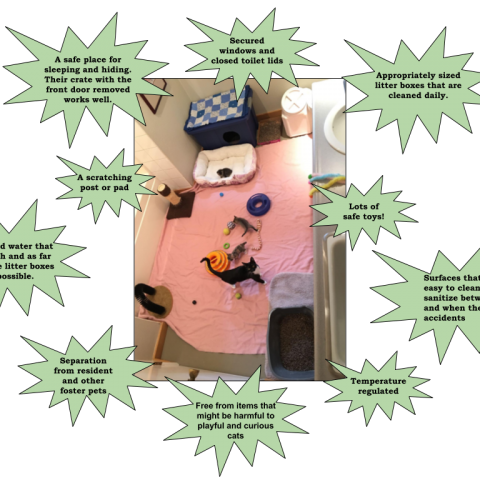
Common Behavior Concerns
It's important to remember that your foster cat has recently been through several difficult transitions. They are feeling unsure of things and even though we know a foster home is a fabulous place, they may still struggle with the transition. Patience is key but the following tips will help with some of the common concerns.
Not Using the Litter Box
There are both medical and behavioral reasons an adult cat may stray from using the litter box. Most reasons are easy to resolve. Begin by determining if the cat is spraying or if it is a case of inappropriate elimination. If there is urine on a vertical surface, you have a cat who is spraying and if the urine is on a horizontal surface, you may have a case of inappropriate urination. Notify the Foster Coordinator immediately of any cases of either.
Spraying is likely the result of stress. A new home (even a really great foster home), the presence of another pet or being recently or still unaltered may all contribute to this behavior. The cat is trying to feel more safe and secure. Begin by assessing the likely cause of the spraying. Confine the cat to a smaller and easily cleanable space, separate from children and other pets.
Inappropriate urination or defecation can also be the result of stress but it may also be a simple dislike for the litter type, litter box location, lack of an appropriate amount of litter boxes, arthritis or a urinary tract infection. To resolve, begin by keeping a clean litter box. Scoop it a couple times daily and completely dump and sanitize it on a weekly basis. Provide your foster cat with more than one litter box, and if possible place one in the area that they are using instead. Use an uncovered litter box with unscented cat litter and if needed try other types of litter to find what they like. For example, you can try clumping, non-clumping, pellets, wheat based, or even soil. There is also Cat Attract litter which has enzymes that will encourage the cat to the litter box.
In both cases, be sure to thoroughly clean the affected area with an enzymatic cleaner that was designed for cat urine. After cleaning, you can utilize Feliway as an added support. Any instances of straining to urinate, blood in the urine or frequent attempts to urinate and not producing a normal amount should be reported to Animal Health immediately.
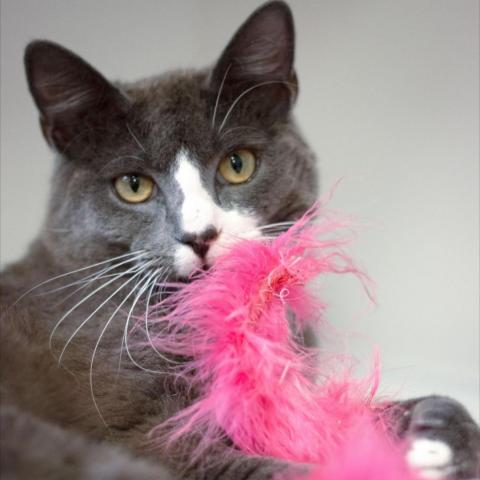
Overarousal
Overarousal may present as a cat who strikes, growls or even bites in response to something that excites them. This may be another cat, a dog or may be as simple as petting. Some cats are more prone to this behavior than others. In response to these behaviors, we should seek to reduce the exposure to the things that cause this response. You can remove other pets or limit petting to a location or amount of time that is more comfortable. Once you understand their threshold, you can begin to work on desensitization. You can use treats or wet food to slowly acclimate the cat to these stimuli. Go slow! For example, use a photo of another cat and then treat. Very gradually increase their exposure to the stimuli, being cautious to stop before they are at their threshold. Keep sessions short and do them several times daily.
Some cats can become over aroused in the form of play. You should never encourage your foster cat to bite or kick at your hands or feet. Use wand or dangling toys to encourage the cat to play appropriately and move them away from your body. Keep play sessions short and end before they become too aroused. Always reward positive interactions and behaviors, and ignore negative behaviors.


Confident Cat Program
The shelter is a busy place for cats. Many cats struggle in this environment and may exhibit extreme fear or even reactivity. Some of these cats are scared house cats who when given a more safe environment are friendly. Others are actually undersocialized cats that may never be comfortable with people interacting with them. Generally a foster home is the best way to determine the difference. By following the below program, we should be able to know the difference in a few short weeks. This program has proven time and again to be successful. If you find that you are not able to move through these steps in about three weeks, contact the Foster Coordinator with an update and a new plan will be put in place.
Set Up
One of the most important components of the program is to have the right set up. Generally a large dog crate, a rolling cage, or a small bathroom are the best places to start. Ideally, the cats should be able to observe normal household activities but not be overwhelmed by them. They should be provided a space to hide so they can take breaks, but make sure that they are not out of reach. Adjust the location of the acclimation area as needed to provide balance. Fearful cats should not have access to the entire house. This will drastically increase the amount of time needed for them to come around and may cause us to assume an inaccurate assessment of their degree of socialization.
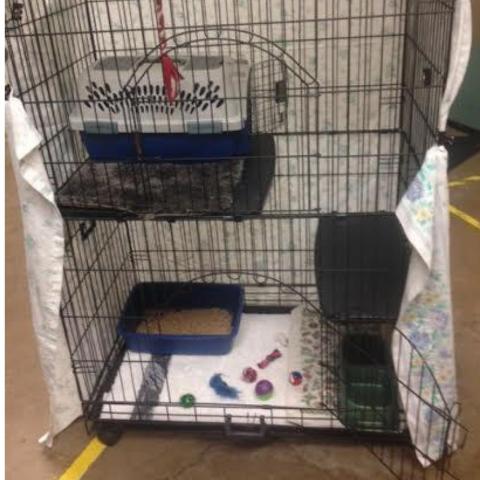
Handling
To begin, offer your foster cat a treat they love-canned food, baby food, tuna oil on canned food etc. and walk away. Strive for three to five sessions a day. Establish a routine that they can predict. After the first several days, begin staying in the area after feeding them. Over the next week, gradually remain closer to their kennel while they eat. If they stop eating, you are staying too close. Continue to stay under their threshold but keep lingering longer until you are able to sit right outside their kennel. Next, try leaving your hand near the food. Then try reaching in for a pet on the face or head. If this step is too much, you can try petting with an inanimate object, such as a wand toy or a back scratcher. Always stop progressing when they stop eating.
Continue these interactions until you are able to comfortably pet them with food. Next, you want to try petting before offering food and give a treat after the touch. Try coaxing the cat onto your lap with food or a toy. Continue to normalize household sounds through these days.
Once the cat is comfortable with you petting and responding positively to it, you can increase their living space. Continue to offer food or toys as an incentive to interact with you and improve the degree of trust.
Getting Ready for Adoption
Once you are able to confidently pet your foster cat, email a description and bio to the Foster Coordinator. Being able to catch her loose in a room, pick her up or have her come to you for snuggle time are not required before listing for adoption. The adoptive family will be counselled on how to continue your plan in their home. We want to provide the adoptive family with a great foundation but also want to empower them to help, so that we can help the next cat in need.
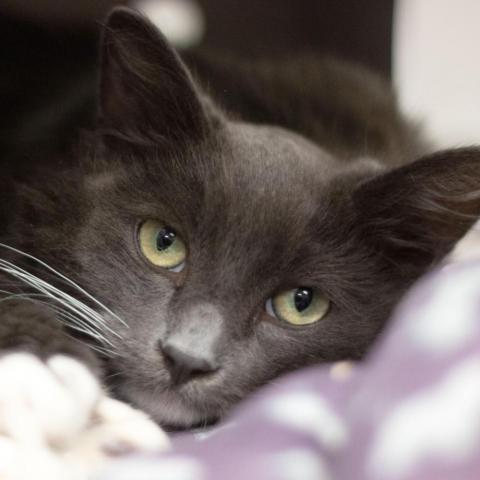
What If They Don't Come Around
Each cat will progress at a different rate but generally speaking you should be able to pet your foster cat by week three even if they do not necessarily enjoy it. If you are not seeing progress at this point, you should contact the Foster Coordinator for tips. The determination may be made to place this cat as a Kitties for Hire. Not all cats are socialized to humans and that is ok, there is a home for those guys too. Following this plan will help us determine the best plan quickly without causing the cat undue stress.
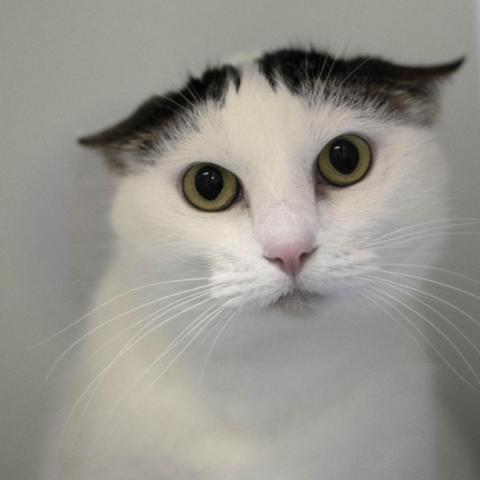
Common Health Concerns
All cats should receive health exams before going into foster care and any known health concerns will be discussed with the foster parent prior to pick up. However, it is possible for symptoms to develop after the cats are taken home. Because of this, it is very important to keep your foster cats in a separate area, with separate bedding and without contact to your other household animals. MCAS is not responsible for treating any other animals in the foster home in the event that something is shared from a foster pet.
It is expected that all veterinary care will be provided by MCAS or an approved emergency veterinarian under an emergency situation only. A foster parent may not take a foster pet to any other veterinarian. No medications, prescription or otherwise, are allowed to be given to foster pets unless previously authorized by MCAS veterinarian staff. Failure to follow this rule may result in no longer being a foster parent with MCAS. Any unauthorized veterinary care will not be reimbursed by MCAS.
Diarrhea
Diarrhea can be caused by a variety of things including a change in diet and stress. Soft stool or diarrhea is to be expected the first couple days after coming to your home. If the stool doesn't improve, it may be indicative of a more serious concern. Animal Health should be contacted if it persists for more than 72 hours or is accompanied with lethargy, loss of appetite or vomiting.
Vomiting
Vomiting may also be the result of stress or diet change and should be monitored. If the vomiting continues for more than 48 hours or is accompanied with lethargy or loss of appetite, Animal Health should be contacted.
Fleas
Whenever possible, your foster cat will be treated for fleas before going home with you. Flea treatment should be applied monthly. Contact Animal Health for follow up treatments.
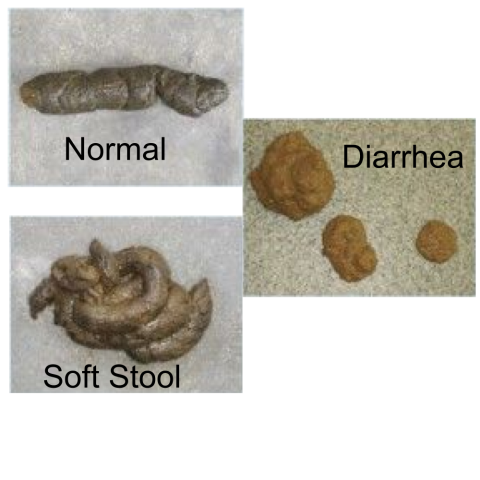
Ear Mites
A cat with ear mites will have crusty black debris in their ears. The ears will often be itchy and may have a foul odor. Treatment is simple with medication, though sometimes more than one treatment is required for complete resolution.
Upper Respiratory Infection (URI)
URI is simply a cat cold. They are generally caused by viruses, but bacterial infections may be involved. Stress can make the cats more susceptible.
URI generally appears as sneezing, discharge from the eyes or nose, congestion, coughing, or swollen eyes.
Mild cases of URI do not need to be seen by a veterinarian. If the cat has clear nasal discharge and is eating, maintaining weight and otherwise acting normally, then an appointment may not be needed. Most mild URIs resolve on their own within seven to ten days. Animal Health should be contacted if the URI has not resolved or if the cat develops lethargy, poor appetite, weight loss, colored nasal discharge, severe congestion or a fever.
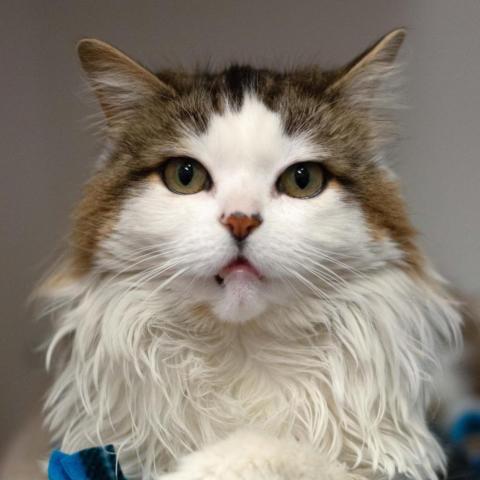
Tips to Encourage Eating
- Increase the odor - cats generally need to smell what they are eating
- Warm canned food a bit
- Add a small amount of tuna or clam juice
- Add low sodium chicken or beef broth (no onions or garlic)
- Offer single meat baby food (no onions or garlic)
- Offer different canned foods with a variety of textures and flavors
- Pet or sit with them - some cats are “social eaters”
- Keep food fresh
Ringworm
Ringworm is fairly uncommon in our population of adult cats. It is a fungal infection and is typically found on the head and legs. The skin will look dry and the hair will be missing. Ringworm is treatable and typically involves medicated baths and an oral medication. It is highly contagious to other animals and humans and can live in the home for very long periods. Contact Animal Health if you suspect that your foster cat has ringworm.
FIV/FeLV
MCAS, in accordance with many local shelters, does not routinely test cats for FIV/FeLV. Testing will be conducted at the discretion of Animal Health. It will be communicated with the foster family when a cat is known to be positive for either. FIV is generally only transmitted through deep fight wounds and mating. FeLV is more easily spread and can include the transmission of saliva through close contact, such as mutual grooming. The virus does not live long in the environment and normal cleaning protocols will eliminate the environmental risk to other cats.
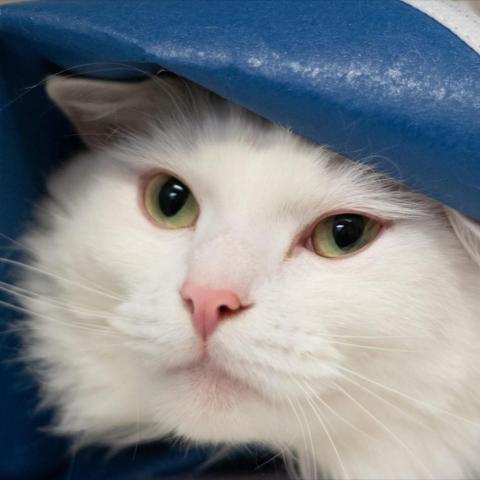
Low Stress Medicating Tips
- Hide the pill
- Cheese
- Wet food
- Baby food
- Liver sausage
- Pill Pockets
- Use your hands
- Wrap the cat in a towel
- Hold the cat’s head and gently tilt it back
- Open its mouth
- Drop the pill on the back of the tongue.
- Close the mouth and hold it shut while you run your hand on their throat or blow gently on their nose until you feel them swallow.
- Follow with food
- Use a pill gun
- This is a tool that will help place the pill in the mouth safely. Ask Animal Health for one and instructions on how to use it.
Chronic Renal Failure
Chronic Renal Failure, also known as kidney disease, is a common condition in older cats and has a variety of causes. Each cat has a different rate of progression and it can be difficult to predict how long the disease will take to progress. Your foster cat is likely to drink and urinate in larger than normal quantities. They may also develop weight loss, poor appetite, decreased energy, anemia and vomiting. A prescription diet is likely to be recommended and will be provided by MCAS. It is essential to make sure these cats have access to water at all times.
Hyperthyroidism
Hyperthyroidism is also common in older cats. It is caused by an abnormally functioning thyroid gland. It can cause excessive drinking and urination, restlessness, vomiting or diarrhea. Cats often lose weight, despite having an eager appetite. Life-long medication is typically required and these cats should always have access to water.
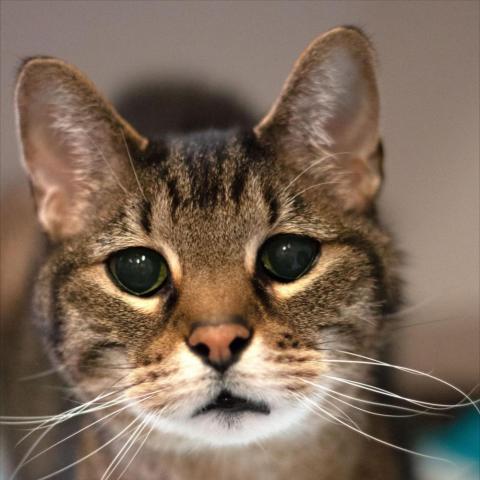
Hospice
MCAS has a hospice program for cats that enter the shelter with a terminally ill condition. These animals may have a variety of medical concerns but are still having a good quality of life. MCAS will provide palliative care for these cats and ask that our foster families provide them with a loving and compassionate home.
Hospice cats will need monthly rechecks at MCAS and may occasionally graduate from the program and be cleared for adoption. At each of your appointments, the Animal Health team will assist with creating the best plan for these cats.
It is common for hospice cats to need subcutaneous fluids and/or medications. Animal Health is available to show anyone the process. We can also have them come to MCAS to receive fluids as needed.
Monitoring your hospice cat's quality of life is important. Cats are exceptionally good at hiding pain and discomfort. As their caregivers, we need to look for the more subtle signs that they may be ready to go. These signs may include: a loss of appetite, significant weight loss, change in litterbox habits, having more bad days than good, difficulty breathing or changes in behavior. Contact Animal Health if you are concerned about any of these symptoms. Animal Health is skilled at making these decisions and are here to talk with you through the process.
All of fostering, but especially hospice care, is a special process and one that takes immense compassion. Please see the Additional Resources page at the end of this handbook for some places for assistance with grief support. Always know that staff are available as well to help you through the harder times of this journey.
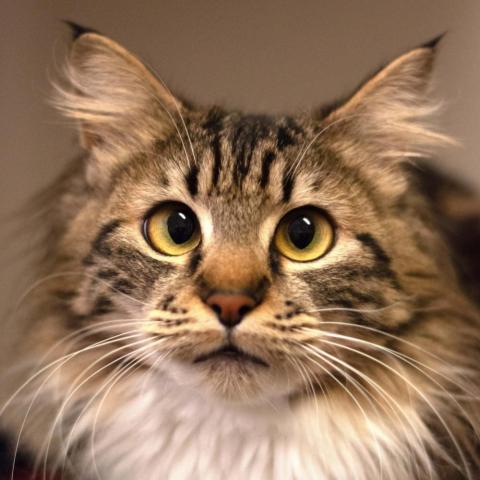
Emergencies
For emergencies between the hours of 8AM and 5:30PM:
- Email the medical team at foster-medical-help@multco.us and call 503-988-9075. Leave a message.
- Come to the shelter immediately! Do not wait for a response.
- Please have the animal ID number with you and provide this number at all points of contact whenever possible but do not let it delay you.
For emergencies between the hours of 5:30PM and 8AM:
- If you are unsure if it is an emergency, refer to your foster contact sheet for a list of current foster mentors for guidance.
- Take the pet to one of the following approved after hours veterinary clinic.
Dove Lewis
1945 NW Pettygrove St
Portland, OR 97209
503-228-7281
NW Veterinary Specialists
16756 SE 82nd Dr
Clackamas, OR 97015
503-656-3999
- If possible, bring your foster's medical records with you.
- Notify the clinic that this is a foster pet with MCAS and they will not charge you for the care they provide.
- Notify MCAS as soon as possible that you have taken an animal to an after-hours veterinarian via email at foster-medical-help@multco.us and a call to 503-988-9075. Please include the animal number.
Not Immediately Concerning - Appropriate to monitor
- URI
- Clear ocular or nasal discharge, sneezing
- Cat is otherwise eating and active
- Poor appetite of less than 48 hours (cat is still active)
- Lethargy (low energy) of less than 48 hours
- Vomiting of less than 24 hours (cat still active and eating)
- Diarrhea of less than 3 days (cat still active and eating)
- Lack of bowel movement of less than 48 hours
- Weight loss of less than 10%
Non-Emergency
Contact Animal Health at foster-medical-help@multco.us to see if an appointment is needed.
- URI
- Significant ocular or nasal discharge
- Any degree of signs where the cat is also lethargic or anorexic
- Diarrhea
- No stool improvement after 3 days (if cat is active and eating)
- Diarrhea lasting 24 hours (if cat is lethargic and anorexic)
- Vomiting
- No improvement after 24 hours (if cat is active and eating)
- Vomiting of less than 24 hours (if cat is lethargic and anorexic)
- Poor appetite of over 48 hours
- Lethargy of more than 48 hours
- Lack of bowel movement of over 48 hours
- Weight loss of more than 10%
- Hair loss
- Skin or ear infections
- Swollen or closed eyes (may be an emergency, contact for guidance)
- Mild trauma, pain or lameness
- Mild bleeding that is no longer active
- Seizures (a single, short-lasting one)
Emergency - Requires immediate attention - See Emergencies on previous page for guidance
- Unresponsive or collapsed
- Severe trauma or pain
- Labored or difficulty breathing
- No urine production after 24 hours of straining to urinate
- Significant active bleeding
- Seizures (more than 3 in a 24 hour period or 1 that lasts more than 3 minutes)
- Continuous vomiting over 24 hours and unable to hold down food/water
Frequently Asked Questions (FAQ)
Q: Can I let my foster Cat interact with my personal pets?
A: We do the best we can to notify foster parents of all known illnesses that a cat may have. Unfortunately, they may be carrying a disease or parasite without showing symptoms for quite some time. We highly recommend keeping foster cats and personal pets separate at all times. At a minimum, we recommend a two-week quarantine period. Personal pets must be up to date on vaccines, parasite preventatives and be healthy.
Q: How much time will I need to dedicate to fostering cats?
A: The time commitment will vary with each case but generally you can expect to spend between one and three hours a day interacting with your foster cat in some form. For cats in foster for behavior reasons, this time is best spent split into short, ten minute sessions.
Q: How does medical treatment work with an MCAS foster pet?
A: As an MCAS foster parent, you will be required to work with our onsite veterinary staff for all routine care and emergencies that occur during the hours of 8AM and 5:30PM. This may mean several visits to our location throughout the time you have the foster cat.
Q: How long will I be fostering each pet?
A: The length of need for fostering will also vary with each cat. Generally cats with a cold only need about two weeks and a hospice cat may be up to six months. There are variations though and each case is unique. The request for foster will generally provide you with an expected time frame.
Q: What are the common reasons that cats need fostering?
A: Cats commonly are in need of a foster home when they are recovering from an illness or injury, have a behavior concern, are too overwhelmed by the shelter, or if they are needing hospice care.
Q: What should I do if my foster cat bites someone?
A: In the event that your cat bites a person and the bite bleeds, you must contact the Foster Coordinator within 24 hours of the incident. It is required by law to have all bites documented and the animal quarantined. This includes bites that are non-aggressive in nature. The quarantine process is simple and requires that the cat remain in your home or at the shelter for a 10 day period and be isolated from people and pets that they were not previously interacting with. We hope to avoid these situations whenever possible, but they do happen and we are here to support you and the cat through the process.
Q: What should I do if my foster cat escapes?
A: If your foster cat escapes, you should make every attempt to get them back into the home as soon as possible. If you are unable to get them quickly, file a lost report on the MCAS lost and found page and contact the Foster Coordinator.
Q: What if I want to adopt one of my foster cats?
A: Foster caregivers may adopt their foster cat. They will need to notify the Foster Coordinator, come to MCAS to complete the adoption application process, and pay the standard adoption fees.
Q: What if one of my friends or family members wants to adopt?
A: Foster parents are encouraged to find adopters for their cats through friends and family members or social media. The potential adopter should come to the shelter to meet with an adoption counselor during normal business hours after the cat is cleared for adoption.
Q: How do I get started?
A: Attend an Informational Session! This is the first step for all MCAS volunteers. These are typically on the 4th Wednesday of the month from 7 to 8PM but you can confirm the dates and times on our website at multcopet.org/events.
Additional Resources
- www.aspcapro.org -A resource for a variety of topics regarding shelter animals and their care.
- www.maddiesfund.org -Another great resource for a wide variety of information including many how-to videos.
- www.sfspca.org -San Francisco SPCA has an online cat behavior library. Also has a great packet on hospice fostering and kitten fostering.
- www.dovelewis.org/pet-owners/pet-loss-support Dove Lewis has a wide range of Pet Loss Support resources including art therapy, remembrance ceremonies, and grief support.
- https://bestfriends.org/resources/cats -Best Friends is the largest No-Kill Animal Sanctuary in the United States. Their website is full of great behavior and medical tips.
